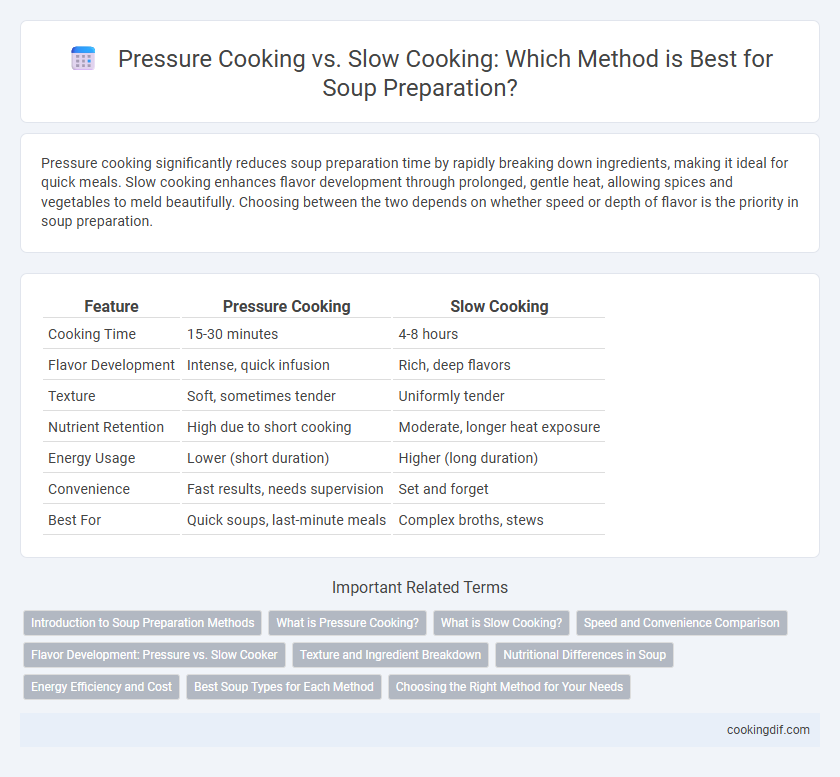Pressure cooking significantly reduces soup preparation time by rapidly breaking down ingredients, making it ideal for quick meals. Slow cooking enhances flavor development through prolonged, gentle heat, allowing spices and vegetables to meld beautifully. Choosing between the two depends on whether speed or depth of flavor is the priority in soup preparation.
Table of Comparison
| Feature | Pressure Cooking | Slow Cooking |
|---|---|---|
| Cooking Time | 15-30 minutes | 4-8 hours |
| Flavor Development | Intense, quick infusion | Rich, deep flavors |
| Texture | Soft, sometimes tender | Uniformly tender |
| Nutrient Retention | High due to short cooking | Moderate, longer heat exposure |
| Energy Usage | Lower (short duration) | Higher (long duration) |
| Convenience | Fast results, needs supervision | Set and forget |
| Best For | Quick soups, last-minute meals | Complex broths, stews |
Introduction to Soup Preparation Methods
Pressure cooking drastically reduces soup preparation time by cooking ingredients at high temperatures and pressures, preserving nutrients and intensifying flavors. Slow cooking allows flavors to develop gradually over several hours, resulting in rich, deeply infused soups with tender textures. Selecting the method depends on the desired eating experience and time availability for soup preparation.
What is Pressure Cooking?
Pressure cooking utilizes high steam pressure to rapidly raise the boiling point of water, significantly reducing soup preparation time while retaining nutrients and flavors. The sealed environment traps steam, increasing temperature beyond 212degF (100degC), which accelerates the cooking process and tenderizes ingredients efficiently. This method is ideal for dense soups with tough meats or dried legumes that typically require long simmering times in slow cooking.
What is Slow Cooking?
Slow cooking involves simmering soup at a low, consistent temperature over an extended period, allowing flavors to meld and ingredients to tenderize thoroughly. This method enhances the depth of taste by breaking down tough fibers and extracting maximum nutrients from vegetables and meats. Slow cookers maintain a steady heat typically between 170degF to 280degF, making them ideal for recipes that benefit from gradual cooking, such as hearty stews and bone broths.
Speed and Convenience Comparison
Pressure cooking drastically reduces soup preparation time, often cooking meals in under an hour by using high steam pressure to quickly break down ingredients. Slow cooking, while significantly longer--typically between 6 to 8 hours--requires minimal active attention, allowing flavors to develop deeply with little supervision. Pressure cookers offer convenience through faster results, whereas slow cookers provide set-it-and-forget-it ease, catering to different time and lifestyle needs.
Flavor Development: Pressure vs. Slow Cooker
Pressure cooking intensifies soup flavors quickly by trapping steam and increasing boiling temperature, which extracts deep, concentrated tastes in a fraction of the time compared to slow cooking. Slow cooking allows gradual flavor melding and enhanced ingredient breakdown, resulting in richer, more complex profiles through extended simmering. The choice between pressure cooking and slow cooking directly impacts soup texture and flavor depth, with pressure cooking favoring speed and robustness, while slow cooking promotes layered, nuanced flavors.
Texture and Ingredient Breakdown
Pressure cooking rapidly breaks down tough ingredients, resulting in a smooth, well-blended soup texture with deep infusion of flavors. Slow cooking allows gradual softening of vegetables and meats, preserving some structure for a heartier, chunkier texture that highlights individual ingredients. Each method uniquely influences ingredient breakdown and final soup consistency, catering to different texture preferences.
Nutritional Differences in Soup
Pressure cooking soup preserves more vitamins and minerals due to shorter cooking times and higher temperatures that reduce nutrient degradation. Slow cooking allows flavors to develop deeply but may cause some nutrient loss, especially water-soluble vitamins like vitamin C and B-complex. Choosing pressure cooking optimizes retention of antioxidants and heat-sensitive nutrients in vegetable and meat-based soups.
Energy Efficiency and Cost
Pressure cooking soup significantly reduces cooking time, leading to lower energy consumption and decreased utility costs compared to slow cooking. Slow cookers operate for several hours, consuming more electricity and increasing overall expenses despite their convenience for flavor development. Pressure cookers optimize energy efficiency by cooking soups quickly under high pressure, making them a cost-effective choice for daily meal preparation.
Best Soup Types for Each Method
Pressure cooking is ideal for hearty soups like beef stew, lentil, and bean soups, as it tenderizes tough ingredients quickly while preserving flavors and nutrients. Slow cooking excels with delicate soups such as chicken noodle, vegetable, and creamy bisques, allowing flavors to meld gently over time without overcooking. Choosing the right method depends on the soup's ingredients and desired texture, with pressure cooking suited for robust, dense soups and slow cooking better for light, layered flavors.
Choosing the Right Method for Your Needs
Pressure cooking soups reduces cooking time significantly, locking in flavors and nutrients while achieving tender ingredients in under an hour. Slow cooking allows gradual flavor development and is ideal for recipes requiring long simmering, creating rich and complex profiles with minimal active monitoring. Selecting the right method depends on your schedule and taste preference: use pressure cooking for quick, nutrient-dense meals and slow cooking for deeply infused, hearty soups.
Pressure cooking vs Slow cooking for soup preparation Infographic

 cookingdif.com
cookingdif.com